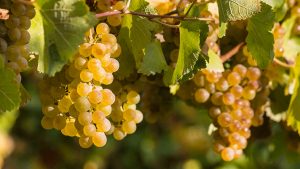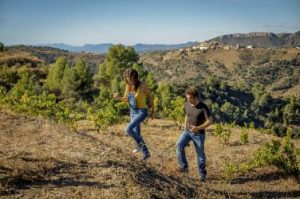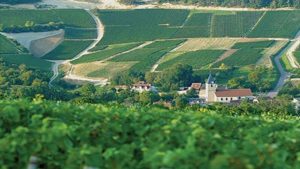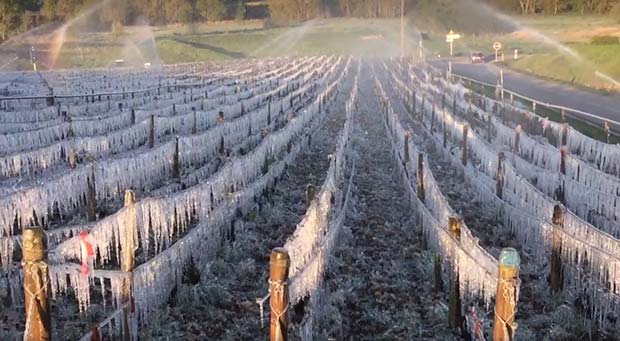
The spring frosts wreaked havoc across a large portion of the vineyards of eastern France, in Champagne, Burgundy, the Loire valley, Alsace, Jura… and even Languedoc-Roussillon and the South-West.
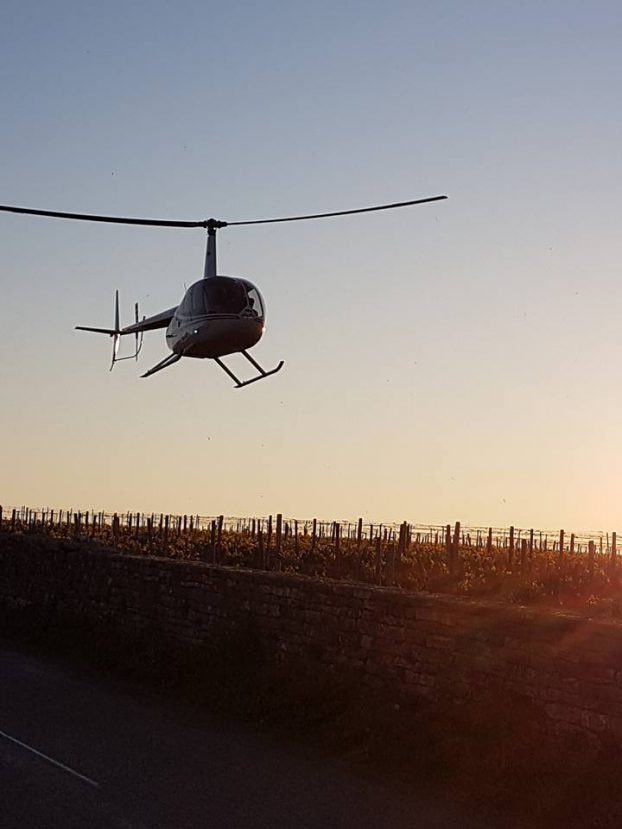
Last week – during the night of Wednesday-Thursday 20 April, to be precise – a number of French wine regions were hit by frost. This event caused even more damage because of the precociously advanced state of the vines’ vegetation cycle, as a result of the fine weather and high temperatures of previous weeks.
Many regions affected by frost; some growers better prepared than others
Although it’s too early to assess the impact on the harvest, what’s already clear is that the damage has been considerable, although the precise extent has varied from region to region.
In the Loire valley, where Anjou, Bourgueil, Saint Nicolas de Bourgueil and Montlouis were severely attacked by frost last year, the picture following the frosts of 20th April remains fairly patchy, with more damage at the eastern end (particularly in Chinon). Some growers protected themselves against this risk by investing in wind turbines which agitate the (warmer) air higher above the vines and direct it towards the ground, drying the air around the vines. The aim of this strategy is to leave the buds less exposed to cold. In Montlouis, other growers employed a variation on this theme by using helicopters to warm the air (seven helicopters for 300 hectares of vines) on Thursday morning at 6:30am (-3°C) for around an hour and a half. Although such a procedure may not seem very ecologically friendly (in fact the impact is not all that far removed from the overheads for running a battery of wind machines), it ultimately proved its effectiveness and saved the precious buds: it increased the temperature at ground level by between 0.5° and 1.2°, dispersing the humidity at the same time; all at a price of around €200/ha.
In Burgundy, once again it was Chablis where the frost exacted the highest toll (more than a third of the harvest was lost last year for the same reason). Here, many growers spent the night outdoors to keep their fuel burners and paraffin candles burning to warm the vine stocks. They also activated water spraying systems in the most sensitive areas, the droplets of water forming an icy shell which protects the buds. Other solutions were also tested – such as bioprotection, which uses preventive treatments to stimulate the plant’s natural defences.
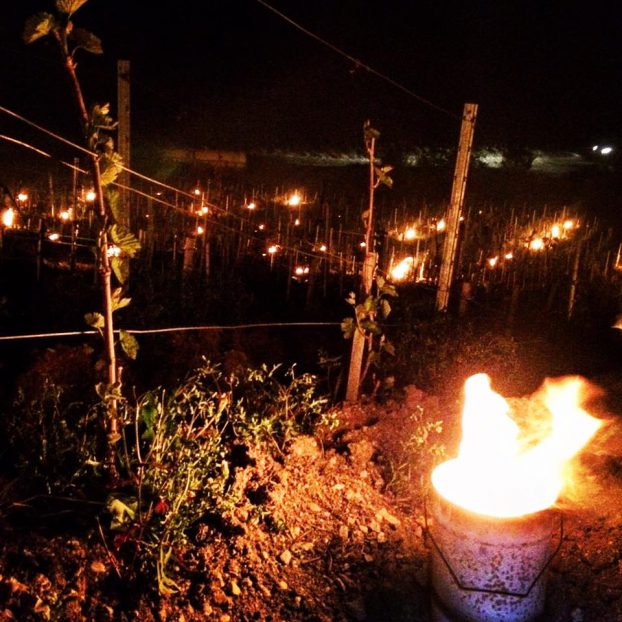
In Champagne, over the night of Wednesday to Thursday, temperatures in the Marne valley fell to -6°C. Such extremes caused many – although not all – buds in a number of parcels to be frost-burnt: the effects of the frost were in fact fairly random, even at the individual rootstock level, with some buds freezing and others spared.
In the Jura, the frost hit hardest during the night of Tuesday to Wednesday, with temperatures as low as -5°C. According to the Comité interprofessionnel des vins du Jura (CIVJ), nearly 45% of the vines were affected; but once again, the reality was much more nuanced: some parcels remained entirely unaffected, while others were completely wiped out. The general prognosis here looks fairly grim.
In Cognac, too, some terroirs were hit by frost, but damage seems to have been fairly limited. In Alsace, too, a large area around Colmar, Scherwiller and Munster was affected by frost. “The growers are reporting high levels of damage of between 60% and 90%. That’s a concern, but we need to find out whether the buds have been totally destroyed, or just on the outside,” says Jérôme Attard, the Chambre d’Agriculture du Haut-Rhin‘s viticultural advisor.
More surprisingly, the frost spread some way beyond France’s northerly vineyards, also causing damage in Languedoc-Roussillon: on the night of the 20th, in the Aude, Minervois and Corbières regions, temperatures fell to between -1°C and -5°C. Such an occurrence is without precedent for decades in this region. Only the coastal regions seem to have been spared. Some parcels were seriously affected, while others were only partially hit: in the Aude region, an estimated 20,000 hectares suffered frostburn.
This is worrying news, as repeat visitations by frost remain a possibility until the traditional Saints de glace (“ice saints”) days in mid-May.
A real headache for growers
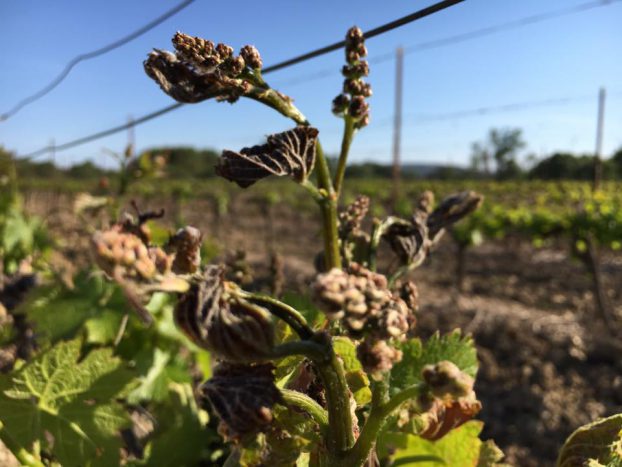
The problem of variable weather in general – and frost in particular, which can cause enormous damage – lies in the fact that many wine estates are not insured against such events: “Out of some 800,000 hectares of vines, a mere 15% are insured” (against weather incidents), says Jérôme Despey, Chairman of the FNSEA agricultural union’s Commission viticole. This is even more problematic given that the frequency of random weather events is increasing, and French national agricultural disaster funds will only pay out in the event of the total destruction of plants and crops by bad weather; partial loss is not sufficient.
Unfortunately, weather which has a serious effect on the cultivation of vines (and also trees), most notably including frost, seems to be turning into a chronic problem; and it appears such disasters are occurring more regularly every year. Global warming is probably one of the main culprits, causing a gradual shift in the vegetation growth cycle. With vines reaching bud break earlier and earlier, they have fewer defences against spring frosts. Last year, spring frost events even affected the Loire and Burgundy vineyards.
The iDealwine team stands alongside all growers who have suffered such losses, and sends them all our encouragement. We sincerely hope the final toll will not be too heavy.
See all wines currently on sale or lookup a price estimate for a wine
To read further on iDealwine Le Blog:
- Sulphure in Wine: is it good or bad?
- Climate: winegrowers fear the consequence of a mild winter
- Influence of yeasts on aromas
- Will corked wine soon be a thing of the past?
- Are “old vines” really old?
Register here to access auctions and fixed-price sales

